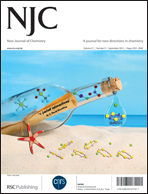A series of homologous push–pull compounds, in which identical donor (a dimethylamino) and acceptor (a malonate ester) functionalities endcap crescent PPV fragments, exhibit striking differences in their supramolecular recognition of cations acting as Lewis acids. The shorter conjugated compound (one phenyl ring) coordinates a wide variety of lanthanide cations (Eu3+, Yb3+ and Er3+) in MeCN solutions to the 1,3-dicarbonyl acceptor end, resulting in an overall supramolecular polarization of the system (red shift of the intramolecular charge-transfer ICT band). With the “hard” cation Sc3+, recognition switches to the tertiary amine donor end, turning the conjugated system from D–π–A to A–π–A, and resulting in a blue shift of the ICT band upon complexation. Interestingly, increasing the conjugation by means of the insertion of sequential p-phenylenevinylene units into the ligand results in coordination to the donor end regardless of cation “hardness” (Sc3+, Eu3+ and Er3+), suggesting a relative change in the nucleophilicity of the two coordinating ends when increasing the length of the conjugated π-bridge. Such a hypothesis is supported by quantum chemical calculations on the ligands and subsequent atomic charges determination using two independent approaches (QTAIM and CHelpG). The characterization of the thermodynamic stabilities and the dimensionalities of the ligand–cation complexes in solution reveals striking differences from case to case, yet increasing affinities (from log Kav = 2.5 to log Kav = 4.9) are recorded with the increase of the π-conjugated bridge.

You have access to this article
 Please wait while we load your content...
Something went wrong. Try again?
Please wait while we load your content...
Something went wrong. Try again?


 Please wait while we load your content...
Please wait while we load your content...